Why we invest in junior explorers, Critical Minerals and more...
Published 28-NOV-2022 14:11 P.M.
|
13 minute read
Why do we invest in high risk junior explorers?
Bigger mining companies that already own producing mines generally have some capital allocated to exploration too, but it’s not their key focus.
Almost all of the “company making” discoveries are made by junior explorers.
For some context, since the year 2000, junior explorers have accounted for ~71% of all discoveries made in Australia.
Over the years, that percentage has been moving in favour of junior explorers, so much so that in 2019, 100% of discoveries were made by junior explorers.
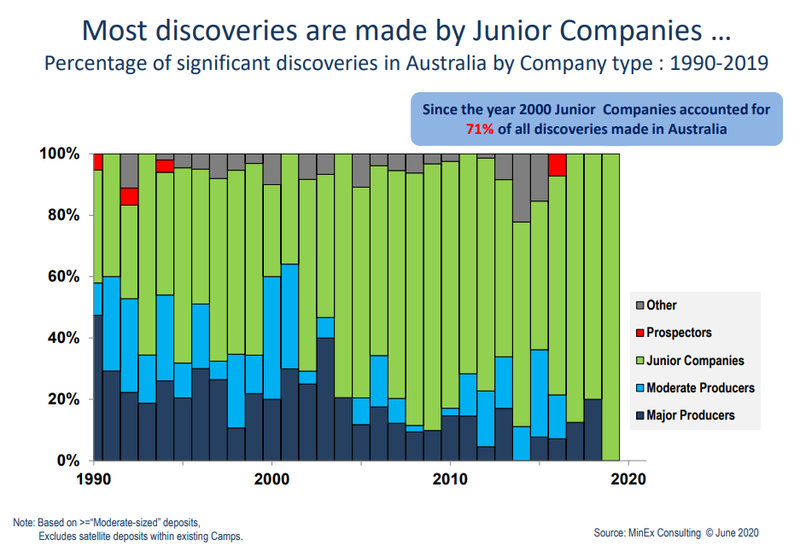
While the risks are obvious (most junior explorers don't end up finding anything), when a discovery is made, a company and its shareholders are rewarded handsomely.
Here are some of the junior explorers we have Invested in that have made discoveries and seen their share prices re-rate significantly in the past year:
- Latin Resources (ASX: LRS) - made a lithium discovery in Brazil and saw its share price go from ~4c per share to a high of ~23c per share.
- Galileo Mining (ASX: GAL) - made a PGE discovery in WA and saw its share price go from ~18c per share to a high of $2 per share.
- Invictus Energy (ASX: IVZ) - not a discovery just yet... but has a working hydrocarbon system and has delivered us a 1,000%+ return from our Initial Entry Price.
Outside of our portfolio, a recent example of a company making discovery is WA1 Resources, which re-rated by ~2,300%+ after making a niobium and rare earths discovery in the West Arunta province in WA.
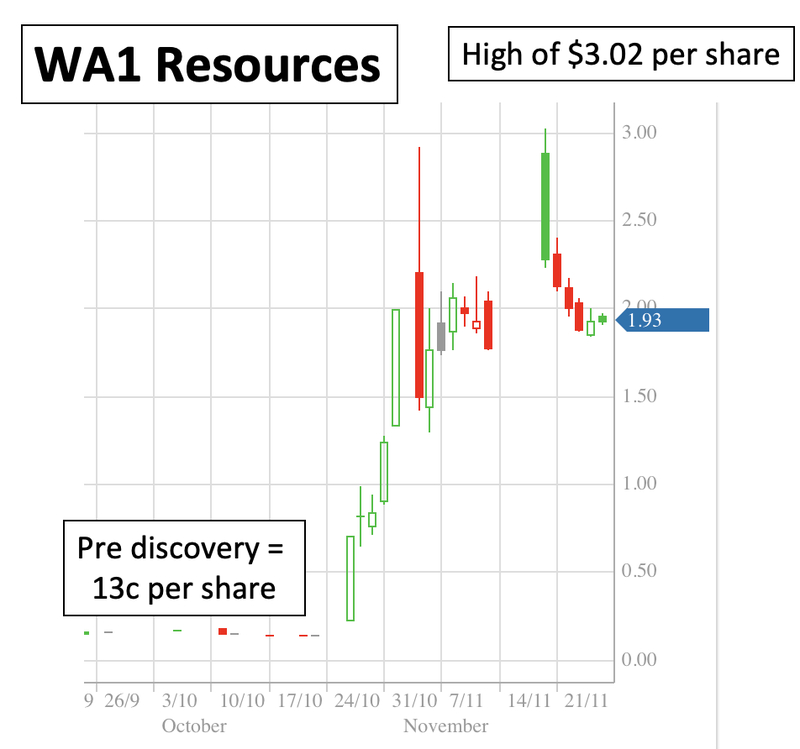
This brings us to an Investment we just launched in our Catalyst Hunter portfolio - Lycaon Resources (ASX: LYN).
LYN is chasing a niobium and rare earths discovery in what is now an emerging rare earths district in the West Arunta province, WA - niobium is a rare earth metal and is listed as a “critical mineral” by the US, EU, Japan, India and Australia.
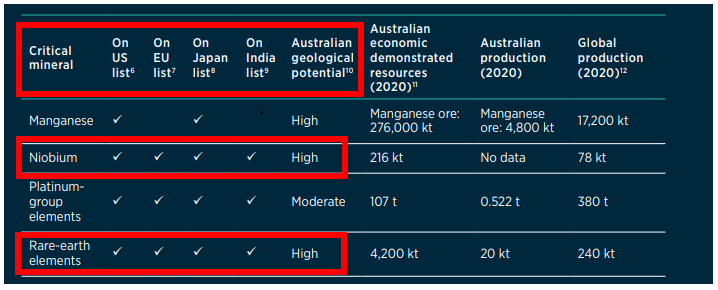
Such is the importance of these minerals that earlier this week treasurer Jim Chalmers, speaking at the PWC Critical Minerals Summit and featured on the front page of The Australian, highlighted rare earths as the gateway for the next mining boom in Australia (read our full take on this news here).
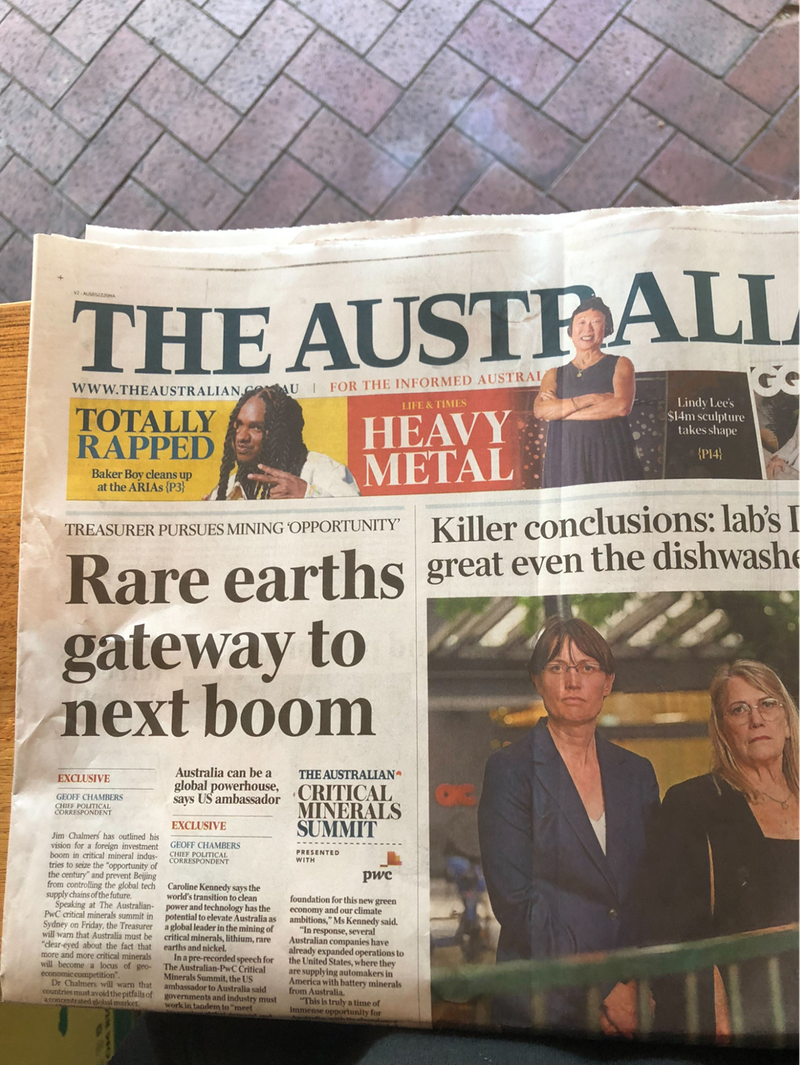
LYN holds ground ~94km north of WA1 Resources (capped at $96M after its recent capital raise) and Encounter Resources (capped at $63.5M).
Similarly to WA1 Resources, LYN is starting from a small base, with a market cap at Friday’s close of ~$13.9M (after the acquisition shares are issued) and is yet to drill its project.
LYN has very few shares on issue, and it’s been a volatile week for the share price. It now looks to have found a base around the 36c mark.
The asset has had some previous drilling that confirmed shallow cover, and most importantly, its home to a discrete magnetic anomaly that looks eerily similar to what WA1 Resources and Encounter Resources drilled to make a discovery.
Importantly LYN’s new ground was pegged BEFORE the WA1 discovery.
As with all of our junior explorers that hold several early stage exploration projects we want to see LYN achieve our “Big Bet” which is to:
"See LYN’s share price to re-rate by over 1,000% off the back of a new metals discovery, and the definition of a deposit significant enough to move into development studies."
NOTE: our “Big Bet” is what we HOPE the ultimate success scenario looks like for this particular Investment over the long term (3+ years). There is a lot of work to be done, many risks involved - just some of which we list in our LYN Investment Memo. Success will require a significant amount of luck. There is no guarantee that our Big Bet will ever come true.
We like making Investments in companies like LYN because of the outsized returns on offer when a junior makes a new metals discovery.
Of course, we are conscious of the probability of this actually happening which is why LYN makes up a small % of our total Investment portfolio.
While it makes up a small percentage of our total Investment portfolio, we are substantial shareholders holding over 5% of LYN’s shares on issue and look forward to the company (hopefully) delivering a big result for us.
Our shareholding is big enough that if a discovery is made it has a material impact on our total portfolio value - but also not big enough so that if things go wrong it brings the whole portfolio down with it.
Alongside LYN we have another exploration Investment chasing a rare earths discovery, Lanthanein Resources (ASX: LNR).
$34M capped LNR has completed its maiden drill campaign in the Gascoyne region of WA next to much bigger rare earths neighbours Hastings ($457M market cap) and Dreadnought ($295M).
We are currently awaiting assays which we expect to be announced this side of Christmas.
LNR recently confirmed that it has found more ironstones (which could possibly contain rare earths) from fieldwork and satellite image analysis, which will provide LNR with a pipeline of drill targets for future campaigns (read our take here).
Is the ASX a Venture Capital (VC) style market for junior explorers?
Over decades of Investing in ASX listed shares one thing that has become increasingly obvious to us is that the ASX is somewhat of a mature, “tech venture capital” market, but for junior mining explorers.
Similar to how the big tech names listed in the USA (like Meta, Amazon and Google) were once small unlisted tech startups, BHP, Rio Tinto and Fortescue Metals were all junior explorers.
Junior explorers often start as a concept - in some cases, this can be a few EM targets or some rock chips and geological maps. The tech equivalent to this would be a couple of techies in their parents' garage building their idea for an app.
In the tech example, the deal is shopped around to private investors who vote on the project's prospects with their capital - this is the pre-seed, seed, series A, B, C and D funding rounds etc.
For Junior explorers who have been privately funded, once larger amounts of capital are required (this could be drilling programs or large scale exploration work), the projects are listed on the ASX through an IPO or vended into a listed vehicle like with Los Cerros’ (ASX:LCL) new gold and battery metals acquisition in Papua New Guinea this week.
Here, the junior explorer pitches its project, the potential discovery it is chasing and then raises a bunch of cash from the capital markets to go and execute its exploration plan - which is basically drilling to make a discovery.
In early stage tech investing the usual strategy is to bet on multiple early stage startups, expecting most to fail, in the hopes that one of them becomes the next Amazon or Google.
The same applies to investing in early stage exploration companies.
While the US has a massive tech venture capital industry, it is almost exclusively focused on opportunities in the tech industry.
The ASX mirrors this but in the junior exploration space, so why is this the case?
We think this is because the mining industry in Australia is well understood and is huge in $ terms.
In the US, early tech successes like PayPal and Google created a number of billionaires who then invested their windfalls into the next wave of tech startups - the cycle kept repeating and created a thriving tech startup ecosystem.
In Australia, lots of money was made by early stage backers of explorers that became mining companies, who then in turn re-invested their winnings into the next batch of early stage explorers, creating a similar style investing ecosystem for junior explorers.
The mining industry is the single biggest sector in Australia making up 14.6% of gross domestic product (GDP), and the biggest company on the ASX (by market cap) is a miner - BHP.
This didn't come about overnight though, the ASX is familiar with the rags to riches stories of these junior explorers.
Stories like Woodside’s, which went from running out of cash as a junior explorer to becoming Australia’s biggest oil and gas player, to Fortescue Metals Group, whose iron ore projects in the Pilbara made Andrew Forrest Australia’s richest man.
The most interesting part, all of these companies started as junior explorers with an idea and some drill targets.
The following chart shows how almost all discoveries made in Australia between 1990 and 2019 were made by junior companies.
(The green bars are the junior companies)
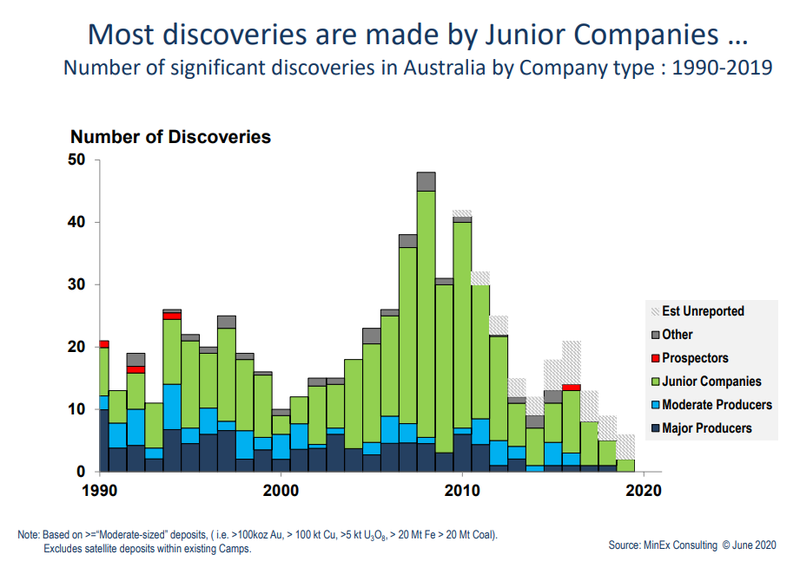
This may come as a surprise to some but not to us...
The majors in the mining space are so busy optimising the performance of their already operating mega projects, with time better spent extracting more cash out of an existing project than spent looking for new discoveries.
Inherently, this means the majors are more inclined to come in and buy out a junior explorer once it has exploration success - instead of spending capital competing with these junior explorers for new discoveries.
The majors will generally buy out a new discovery, deploy a large amount of drilling to prove up and extend the resource and then quickly throw massive amounts of cash at the project to put it into development.
As these larger companies become more disciplined with their capital, the overall trend is also working in favour of junior companies. Over the last two decades, the major to medium level operators are committing less capital towards exploration and more towards optimising mature projects.
More and more of the big discoveries are being made by juniors now than they were 20+ years ago.
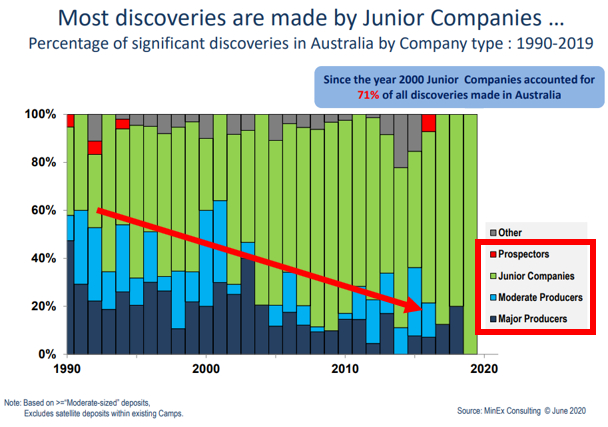
This junior end of the market is where we think the opportunity exists for Investors willing to spend time researching these companies, meeting with the management teams and more importantly, willing to take a few losses with the hope of one day striking exploration success.
Often these are companies capped at <$20M, in the event a discovery is made over a short period of time (2-5 years) can re-rate into the billions of $ depending on the size/scale of the discovery made.
This is why we think the rewards on offer can be so large that investing in the industry makes all of the dusters (failed drilling attempts) worth it.
What do we look for and what are we Investing in next?
We are currently in the middle of making Investments in a group of explorers chasing a resource discovery.
We are still in the process of finalising which companies we will be Investing in and are considering the following:
- The type of metal being targeted - it needs to have a medium-long term structural shortage where new supply is needed (new discoveries)
- Discovery potential - the projects tick the boxes required to pass our due diligence process.
- Quality management - the company's team has been there and done it before.
IF a discovery is made by one of them, then we hope it will far outweigh any losses we have on the other companies (assuming they find nothing).
Keep an eye out for this in the coming weeks.
🗣️ This week’s Quick Takes
BOD: New CBD delivery format showing up available alternatives
GAL: Rhodium grades increasing at depth
IVZ: Invictus doing a sidetrack well to try and obtain a fluid sample
LRS: Diamond drilling a ~5km copper porphyry target in Peru
LRS: High grade lithium in Argentina?
NHE: Noble Helium’s Neighbour Gets a Rig
RAS: Maiden lithium drilling program completed
TG1: Option to acquire Pilbara nickel-copper-PGE project
This week in our Portfolios 🧬 🦉 🏹
Los Cerros (ASX: LCL)
On Friday, LCL announced it has acquired multiple high-grade copper, gold and nickel targets across five project areas in Papua New Guinea (PNG).
LCL’s new project has some of the highest grade rock chip assays we have seen with massive nickel sulphides measuring 45.8% nickel; surface trenches with 2.6% copper and 11.5g/t gold grades; and historic drill intercepts measuring 35m at a grade of 3.04g/t gold from 136m.
📰 Read our full Note: LCL acquires new gold and battery metals project - drill campaign incoming
Noble Helium (ASX: NHE)
This week our helium exploration Investment Noble Helium (ASX: NHE) took another step towards executing its planned 2023 drilling program.
NHE brought in Dermot O’Keeffe as drilling exploration manager.
O’Keeffe and NHE managing director Justyn Wood have a long history together that dates back to the early 2000s.
The pair helped to open the Albertine Rift Basin in western Uganda, making two oil discoveries for Hardman Resources which was then bought out for $1.5BN.
These were what’s called Basin Margin Fault Closure plays which had a 100% success rate and are the same type that NHE is drilling.
This moves NHE one step closer towards taking a shot at our Big Bet for the company which is to see the following:
“NHE discovers the world’s largest helium reserve held by a single company and is strategically acquired by a major company OR a state owned enterprise to secure supply (USA, China, Qatar).”
📰 Read our full Note: “Drilling” Manager Appointed - that can only mean one thing...
Lycaon Resources (ASX: LYN) ⚠️New Investment ⚠️
The latest addition to our portfolio is critical metals explorer Lycaon Resources (ASX: LYN).
LYN is a small, early stage explorer looking to make a niobium and rare earths discovery in the newly opened West Arunta province in WA.
LYN’s ground hosts a similar EM anomaly to the one where WA1 Resources made a niobium & rare earths discovery - re-rating the company’s share price by over 1,800%.
We are Invested in LYN to see it drill out its project and hopefully make a discovery of its own, this forms the basis for our LYN Big bet which is to:
"See LYN’s share price to re-rate by over 1,000% off the back of a new metals discovery, and the definition of a deposit significant enough to move into development studies."
📰 Read our full Note: New Portfolio Addition: Early stage critical metals explorer
⏲️ Upcoming potential share price catalysts
Updates this week:
- IVZ: drilling its giant gas prospect in Zimbabwe
- This week IVZ announced that it would be drilling a sidetrack well which it expects to take 12-18 days, this is the final step before IVZ has all of the data on hand to be able to declare a discovery. To see what Scott had to say about the announcement check out the following video: Mukuyu-1 Preliminary Results and Sidetrack Shareholder Briefing
- GAL is undertaking a second round of drilling at its Callisto PGE discovery in WA.
- This week GAL put out some of the highest grade rhodium assays to date from its PGE discovery. See our Quick Take on this news here.
- RAS: Drilling for lithium next door to Core Lithium in the Northern Territory.
- This week RAS completed its drilling program, we are now waiting on assays to see if RAS has made a discovery. See our Quick Take on the news here.
No material news this week:
- PFE: Assay results for manganese (Weelarrana) project.
- LNR: Drilling for rare earths along strike from Hastings Technology Metals
- GTR: Drilling results for uranium in Wyoming, USA.
- TYX: Drilling for lithium in Angola.
- PRL: Awaiting final execution of a joint development agreement with Total Eren
- TTM: Drilling its copper porphyry target in Ecuador.
Have a great weekend,
Next Investors.
General Information Only
S3 Consortium Pty Ltd (S3, ‘we’, ‘us’, ‘our’) (CAR No. 433913) is a corporate authorised representative of LeMessurier Securities Pty Ltd (AFSL No. 296877). The information contained in this article is general information and is for informational purposes only. Any advice is general advice only. Any advice contained in this article does not constitute personal advice and S3 has not taken into consideration your personal objectives, financial situation or needs. Please seek your own independent professional advice before making any financial investment decision. Those persons acting upon information contained in this article do so entirely at their own risk.
Conflicts of Interest Notice
S3 and its associated entities may hold investments in companies featured in its articles, including through being paid in the securities of the companies we provide commentary on. We disclose the securities held in relation to a particular company that we provide commentary on. Refer to our Disclosure Policy for information on our self-imposed trading blackouts, hold conditions and de-risking (sell conditions) which seek to mitigate against any potential conflicts of interest.
Publication Notice and Disclaimer
The information contained in this article is current as at the publication date. At the time of publishing, the information contained in this article is based on sources which are available in the public domain that we consider to be reliable, and our own analysis of those sources. The views of the author may not reflect the views of the AFSL holder. Any decision by you to purchase securities in the companies featured in this article should be done so after you have sought your own independent professional advice regarding this information and made your own inquiries as to the validity of any information in this article.
Any forward-looking statements contained in this article are not guarantees or predictions of future performance, and involve known and unknown risks, uncertainties and other factors, many of which are beyond our control, and which may cause actual results or performance of companies featured to differ materially from those expressed in the statements contained in this article. S3 cannot and does not give any assurance that the results or performance expressed or implied by any forward-looking statements contained in this article will actually occur and readers are cautioned not to put undue reliance on forward-looking statements.
This article may include references to our past investing performance. Past performance is not a reliable indicator of our future investing performance.






